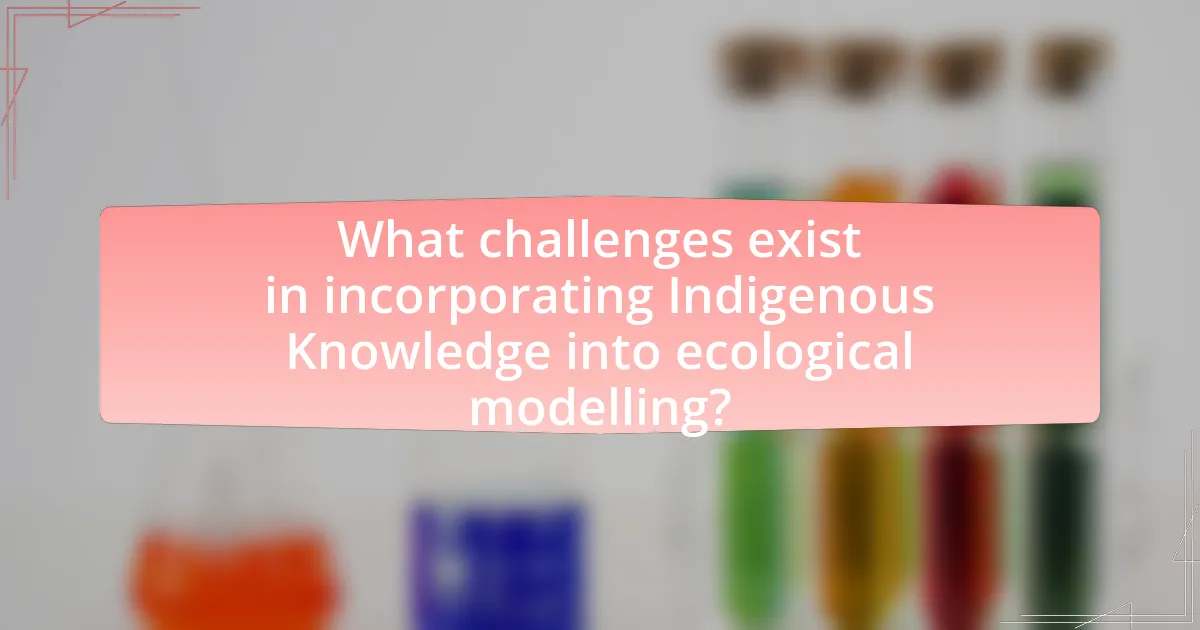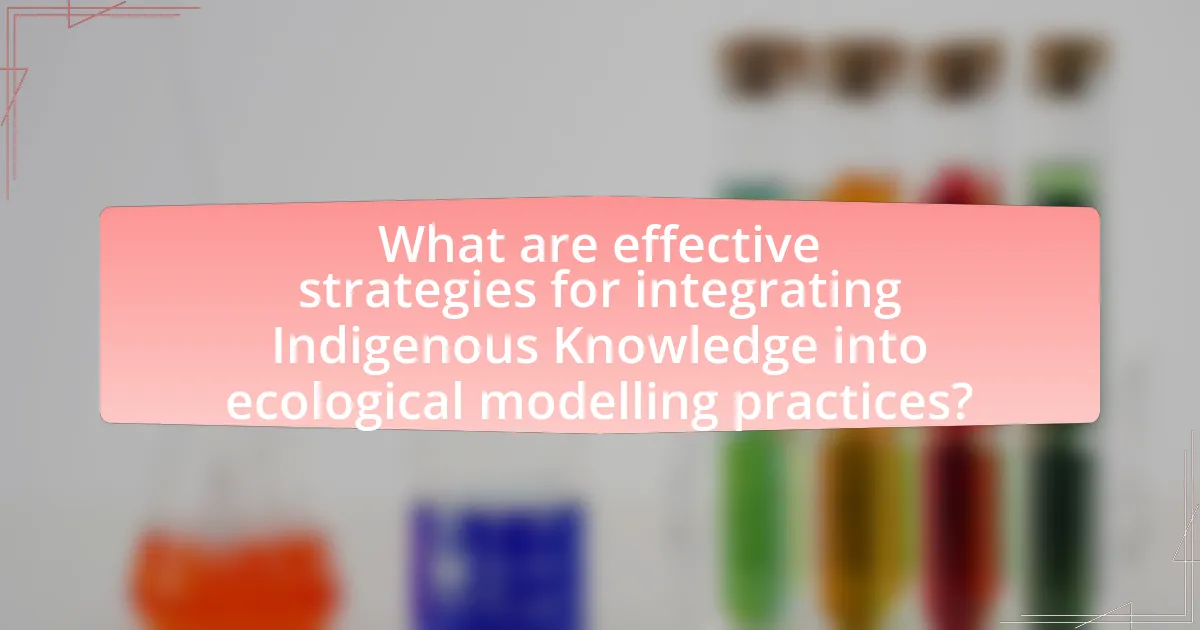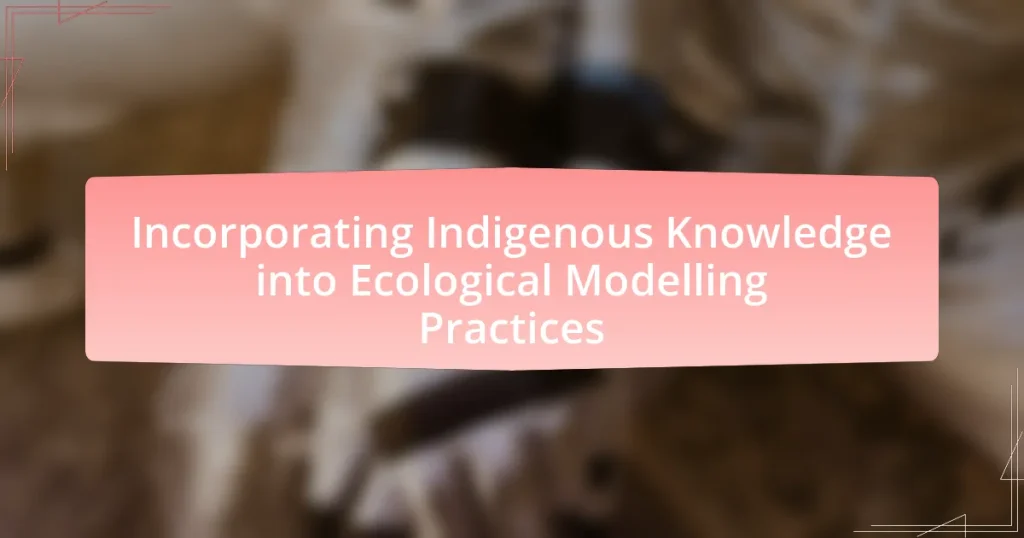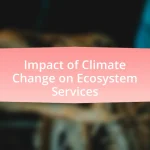Incorporating Indigenous Knowledge into ecological modelling practices involves integrating the traditional ecological insights and cultural perspectives of Indigenous peoples with scientific models to enhance the understanding of ecosystems. This article explores how Indigenous Knowledge contributes to ecological modelling by providing a holistic understanding of local ecosystems, informed by centuries of observation and interaction with the environment. It discusses the key principles of Indigenous Knowledge relevant to ecology, the differences between Indigenous and Western scientific approaches, and the importance of collaboration between Indigenous communities and researchers. Additionally, the article addresses the challenges and barriers to integration, effective strategies for collaboration, and best practices for ethical engagement with Indigenous knowledge holders.

What is Incorporating Indigenous Knowledge into Ecological Modelling Practices?
Incorporating Indigenous Knowledge into ecological modelling practices involves integrating traditional ecological insights and cultural perspectives of Indigenous peoples into scientific models that assess and predict ecological dynamics. This integration enhances the understanding of ecosystems by incorporating local knowledge about species behavior, land use, and environmental changes that have been accumulated over generations. Research indicates that Indigenous knowledge can improve the accuracy of ecological models, as it often includes observations and understandings that are not captured by conventional scientific methods, thereby leading to more effective conservation strategies and sustainable resource management.
How does Indigenous Knowledge contribute to ecological modelling?
Indigenous Knowledge contributes to ecological modelling by providing a deep understanding of local ecosystems, informed by centuries of observation and interaction with the environment. This knowledge enhances ecological models by incorporating traditional ecological practices, species behavior, and landscape changes that may not be captured by conventional scientific methods. For instance, Indigenous communities often possess detailed insights into seasonal changes, biodiversity, and resource management, which can improve the accuracy and relevance of ecological predictions. Studies have shown that integrating Indigenous Knowledge with scientific data leads to more effective conservation strategies and sustainable resource management, as evidenced by successful collaborations in various regions, such as the use of traditional fire management practices in Australia to reduce wildfire risks.
What are the key principles of Indigenous Knowledge relevant to ecology?
The key principles of Indigenous Knowledge relevant to ecology include holistic understanding, interconnectedness, sustainability, and respect for the land. Holistic understanding emphasizes viewing ecosystems as integrated wholes rather than isolated parts, which aligns with the traditional ecological knowledge that Indigenous peoples have developed over generations. Interconnectedness highlights the relationships between all living beings and their environments, recognizing that changes in one aspect of an ecosystem can affect others. Sustainability is a core principle, advocating for practices that ensure resources are available for future generations, as seen in Indigenous land management practices that prioritize biodiversity and ecosystem health. Lastly, respect for the land reflects a deep cultural and spiritual connection to nature, guiding stewardship practices that maintain ecological balance. These principles are validated by numerous studies, such as the work by Berkes (2012) in “Sacred Ecology,” which illustrates how Indigenous practices contribute to ecological resilience and sustainability.
How does Indigenous Knowledge differ from Western scientific approaches?
Indigenous Knowledge differs from Western scientific approaches primarily in its holistic and experiential nature, emphasizing relationships and interconnectedness within ecosystems. While Western science often relies on quantitative data, controlled experiments, and objective analysis, Indigenous Knowledge is rooted in long-term observations, cultural practices, and oral traditions that reflect a deep understanding of local environments. For instance, Indigenous communities have utilized their knowledge of seasonal changes and animal behaviors for generations, which informs sustainable practices that are often overlooked by Western methodologies. This contrast highlights the importance of integrating diverse knowledge systems for more effective ecological modeling and management.
Why is it important to incorporate Indigenous Knowledge in ecological modelling?
Incorporating Indigenous Knowledge in ecological modelling is crucial because it enhances the understanding of local ecosystems and biodiversity. Indigenous Knowledge, developed over generations, provides insights into species behavior, ecological relationships, and sustainable practices that are often overlooked in conventional scientific approaches. For example, studies have shown that Indigenous land management practices, such as controlled burns, can significantly improve ecosystem health and resilience, as evidenced by research published in the journal “Ecological Applications” by authors such as David L. Lewis and others. This integration leads to more accurate models that reflect the complexities of ecosystems and promotes more effective conservation strategies.
What benefits does Indigenous Knowledge provide for ecological accuracy?
Indigenous Knowledge enhances ecological accuracy by providing a deep understanding of local ecosystems developed over generations. This knowledge includes insights into species behavior, seasonal changes, and land management practices that are often overlooked by conventional scientific approaches. For instance, Indigenous practices such as controlled burns have been shown to promote biodiversity and reduce wildfire risks, as evidenced by studies indicating that areas managed with Indigenous techniques exhibit greater ecological resilience. Furthermore, Indigenous Knowledge incorporates a holistic view of the environment, recognizing the interconnectedness of species and habitats, which is crucial for accurate ecological modeling.
How can Indigenous perspectives enhance biodiversity conservation efforts?
Indigenous perspectives can enhance biodiversity conservation efforts by integrating traditional ecological knowledge with scientific practices. This knowledge, developed over generations, includes insights into local ecosystems, species interactions, and sustainable resource management. For instance, Indigenous land management practices, such as controlled burns, have been shown to promote biodiversity and reduce wildfire risks, as evidenced by studies in Australia where Indigenous fire management has led to healthier ecosystems. Additionally, Indigenous communities often prioritize the preservation of cultural and spiritual connections to the land, which can foster a more holistic approach to conservation that values biodiversity not just for its ecological benefits but also for its cultural significance.

What challenges exist in incorporating Indigenous Knowledge into ecological modelling?
Incorporating Indigenous Knowledge into ecological modelling faces several challenges, primarily related to differences in worldviews and methodologies. Indigenous Knowledge often emphasizes holistic, place-based, and experiential understanding of ecosystems, which contrasts with the reductionist and quantitative approaches typically used in ecological modelling. This fundamental difference can lead to difficulties in integrating Indigenous perspectives into existing scientific frameworks, as seen in studies like “Indigenous Knowledge and Ecological Modelling: A Review” by Davis and Slobodkin, which highlights the need for bridging these epistemological divides. Additionally, issues such as data ownership, representation, and the potential for misinterpretation of Indigenous Knowledge further complicate its incorporation into ecological models.
How can cultural sensitivities impact the integration process?
Cultural sensitivities can significantly impact the integration process by influencing communication, collaboration, and trust among stakeholders. When integrating Indigenous knowledge into ecological modeling practices, recognizing and respecting cultural values and beliefs is essential for fostering meaningful partnerships. For instance, a study by the United Nations Educational, Scientific and Cultural Organization (UNESCO) highlights that inclusive approaches that honor Indigenous perspectives lead to more effective environmental management outcomes. This demonstrates that cultural sensitivities not only facilitate smoother interactions but also enhance the relevance and applicability of ecological models in diverse contexts.
What are the potential conflicts between Indigenous Knowledge and scientific data?
Potential conflicts between Indigenous Knowledge and scientific data arise primarily from differing epistemologies and methodologies. Indigenous Knowledge is often based on long-term, place-based experiences and cultural practices, while scientific data typically relies on empirical evidence and standardized methods. For instance, Indigenous perspectives may prioritize holistic and relational understandings of ecosystems, contrasting with the reductionist approaches commonly used in scientific research. This divergence can lead to conflicts in resource management decisions, as seen in cases where Indigenous land stewardship practices are overlooked in favor of scientifically derived models that do not account for local ecological knowledge. Additionally, the validation processes for knowledge can differ; Indigenous Knowledge may not fit within the frameworks of scientific rigor, leading to marginalization of Indigenous voices in ecological discussions.
How can researchers address these cultural sensitivities effectively?
Researchers can address cultural sensitivities effectively by engaging with Indigenous communities through collaborative partnerships. This approach ensures that the knowledge and perspectives of Indigenous peoples are integrated into ecological modeling practices, fostering mutual respect and understanding. For instance, studies have shown that involving Indigenous knowledge holders in research design and implementation leads to more culturally relevant and scientifically robust outcomes, as seen in the work of the United Nations Educational, Scientific and Cultural Organization (UNESCO) on Indigenous knowledge systems. By prioritizing open communication, respecting traditional practices, and acknowledging the historical context of Indigenous communities, researchers can create a more inclusive and effective research environment.
What are the barriers to collaboration between Indigenous communities and scientists?
Barriers to collaboration between Indigenous communities and scientists include differing worldviews, communication challenges, and historical mistrust. Indigenous communities often prioritize holistic and relational approaches to knowledge, while scientists may focus on empirical and reductionist methods. This fundamental difference can lead to misunderstandings and misalignment in project goals. Additionally, language barriers and varying terminologies can complicate effective communication. Historical injustices, such as colonization and exploitation, have fostered mistrust towards scientific institutions, making Indigenous communities hesitant to engage. These factors collectively hinder the establishment of productive partnerships aimed at integrating Indigenous knowledge into ecological modeling practices.
What role does trust play in fostering collaboration?
Trust is essential in fostering collaboration as it creates a safe environment for open communication and sharing of ideas. When individuals trust each other, they are more likely to engage in honest discussions, share valuable insights, and work towards common goals without fear of judgment or misrepresentation. Research indicates that high levels of trust among team members lead to increased cooperation and improved problem-solving capabilities, which are critical in complex fields like ecological modeling that benefit from diverse perspectives, including Indigenous knowledge. For instance, studies show that collaborative projects that integrate Indigenous knowledge often succeed when built on mutual respect and trust, leading to more effective and culturally relevant ecological solutions.
How can communication be improved between Indigenous knowledge holders and researchers?
Communication can be improved between Indigenous knowledge holders and researchers by establishing mutual respect and understanding through collaborative frameworks. Collaborative frameworks, such as co-design and participatory research, facilitate the sharing of knowledge and ensure that Indigenous perspectives are integrated into research processes. For instance, the United Nations Declaration on the Rights of Indigenous Peoples emphasizes the importance of free, prior, and informed consent, which can guide researchers in engaging with Indigenous communities respectfully. Additionally, creating platforms for ongoing dialogue, such as workshops and community meetings, allows for continuous exchange of ideas and fosters trust. Research shows that when Indigenous knowledge is valued and incorporated, it enhances ecological modeling practices, leading to more effective environmental management outcomes.

What are effective strategies for integrating Indigenous Knowledge into ecological modelling practices?
Effective strategies for integrating Indigenous Knowledge into ecological modelling practices include collaborative partnerships with Indigenous communities, incorporation of traditional ecological knowledge (TEK) into data collection and analysis, and recognition of Indigenous perspectives in model development. Collaborative partnerships ensure that Indigenous voices are included in the modelling process, fostering mutual respect and understanding. Incorporating TEK allows for the integration of long-term ecological observations and cultural practices that can enhance model accuracy and relevance. Recognizing Indigenous perspectives in model development ensures that the values and priorities of Indigenous communities are reflected, leading to more culturally appropriate and effective ecological outcomes. These strategies have been supported by various studies, such as the work by Davis and Slobodkin (2020), which highlights the importance of integrating local knowledge for improved ecological management.
How can participatory approaches enhance the integration of Indigenous Knowledge?
Participatory approaches enhance the integration of Indigenous Knowledge by fostering collaboration between Indigenous communities and researchers, ensuring that local perspectives and practices are respected and utilized. This collaboration leads to more culturally relevant ecological models that reflect the values and experiences of Indigenous peoples. For instance, studies have shown that involving Indigenous knowledge holders in ecological assessments improves the accuracy and applicability of environmental management strategies, as seen in the work of the United Nations Educational, Scientific and Cultural Organization (UNESCO) which emphasizes the importance of local knowledge in sustainable development initiatives.
What methods can be used to ensure Indigenous voices are heard in ecological modelling?
To ensure Indigenous voices are heard in ecological modelling, participatory approaches such as co-design and co-management are essential. These methods involve Indigenous communities in the decision-making process, allowing them to contribute their traditional ecological knowledge and perspectives. For instance, the use of community workshops and collaborative research initiatives has been shown to enhance the integration of Indigenous knowledge into ecological models, as evidenced by studies like “Integrating Indigenous Knowledge into Ecological Modelling” published in the Journal of Environmental Management, which highlights successful case studies where Indigenous participation led to more effective and culturally relevant ecological outcomes.
How can co-management frameworks facilitate collaboration?
Co-management frameworks facilitate collaboration by establishing shared governance structures that integrate diverse stakeholder perspectives, particularly Indigenous knowledge and practices. These frameworks promote mutual respect and understanding, enabling stakeholders to co-create management strategies that reflect both scientific and traditional ecological insights. For instance, studies have shown that co-management approaches in fisheries have led to improved resource sustainability and community engagement, as seen in the collaborative management of the Great Bear Rainforest in British Columbia, where Indigenous communities and government agencies work together to protect biodiversity while respecting traditional practices.
What best practices should be followed when incorporating Indigenous Knowledge?
Best practices for incorporating Indigenous Knowledge include establishing respectful partnerships with Indigenous communities, ensuring mutual benefit, and integrating traditional ecological knowledge with scientific methods. Respectful partnerships involve engaging Indigenous peoples in the decision-making process, recognizing their rights, and valuing their contributions. Mutual benefit ensures that both Indigenous communities and researchers gain from the collaboration, fostering trust and long-term relationships. Integrating traditional ecological knowledge with scientific methods enhances ecological modeling by providing a holistic understanding of ecosystems, as demonstrated in studies like “Integrating Indigenous Knowledge and Science for Sustainable Resource Management” by Berkes et al. (2016), which highlights the effectiveness of combining these knowledge systems for better environmental outcomes.
How can researchers ensure ethical engagement with Indigenous communities?
Researchers can ensure ethical engagement with Indigenous communities by prioritizing mutual respect, informed consent, and collaboration throughout the research process. This involves actively involving Indigenous voices in decision-making, recognizing their rights to land and resources, and valuing their traditional knowledge as legitimate and essential to ecological understanding. For instance, the First Nations Information Governance Centre emphasizes the importance of Indigenous data sovereignty, which asserts that Indigenous communities should control their own data and research processes. By adhering to these principles, researchers can foster trust and create partnerships that honor Indigenous perspectives and contributions.
What are the key steps for developing a respectful partnership with Indigenous knowledge holders?
The key steps for developing a respectful partnership with Indigenous knowledge holders include establishing trust, engaging in open communication, recognizing and valuing Indigenous knowledge, ensuring mutual benefits, and respecting cultural protocols. Establishing trust involves building relationships over time, demonstrating reliability, and showing genuine interest in Indigenous perspectives. Open communication fosters transparency and allows for the sharing of ideas and concerns, which is essential for collaboration. Recognizing and valuing Indigenous knowledge means acknowledging its legitimacy and integrating it into decision-making processes. Ensuring mutual benefits requires that both parties gain from the partnership, promoting equity and shared goals. Finally, respecting cultural protocols involves understanding and adhering to the customs and practices of Indigenous communities, which is crucial for fostering respect and collaboration.
What practical tips can help in the successful incorporation of Indigenous Knowledge into ecological modelling?
Successful incorporation of Indigenous Knowledge into ecological modelling can be achieved through collaborative partnerships with Indigenous communities. Engaging these communities ensures that their perspectives and traditional practices are integrated into the modelling process. For instance, involving Indigenous elders and knowledge holders in data collection and interpretation can enhance the relevance and accuracy of ecological models.
Additionally, respecting and understanding the cultural context of Indigenous Knowledge is crucial. This involves recognizing the holistic view of ecosystems that Indigenous peoples often hold, which can provide valuable insights into ecological relationships that may be overlooked in conventional scientific approaches.
Furthermore, establishing long-term relationships built on trust and mutual respect fosters an environment where Indigenous Knowledge can be shared openly. This approach has been supported by case studies, such as the collaboration between the Haida Nation and researchers in British Columbia, which demonstrated improved ecological outcomes through the integration of traditional ecological knowledge with scientific methods.
In summary, practical tips include forming collaborative partnerships, respecting cultural contexts, and building trust with Indigenous communities to successfully incorporate their knowledge into ecological modelling.


